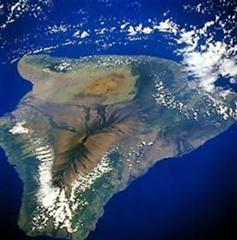
The island of Hawai‘i is the youngest island in the chain, and was formed by five volcanoes, two of which are still active (Mauna Loa and Kilauea). Mauna Loa and Mauna Kea are two of the tallest mountains in the Pacific, and dominate the center of the island.
Nicknames: The Big Island; the Orchid Isle
Island Color: Red
Island Flora: Pua Lehua (a red blossom)
Average daily temperatures: Hilo (71.2° F.); Kailua-Kona (73.1° F.) Mauna Kea summit temperatures range from 31° to 43° F.
Average annual rainfall: 131 inches at Hilo Airport; 10 inches near Kawaihae.
Population
Resident population (2005): 167,293
By age (2005): Under 18 (25.2%); 18-64 (61.5); 65 and over (13.3)
By ethnic groups (2005): Hawaiian/Part Hawaiian (27.5%); Caucasian (34.0); Japanese (11.2); Filipino (7.0)
Main cities and towns (2000): Hilo (40,759); Kailua-Kona (9,870); Waimea (7,028)
Tourism
Visitor arrivals (2005): 1,521,536
Major attractions are the Hawai‘i Volcanoes National Park, Akaka Falls, Pu‘uhonua o Honaunau National Historical Park (City of Refuge), Pu‘ukohola Heiau National Historic Site and Lapakahi State Historic Park.
Additional activities include viewing petroglyph sites, deep-sea fishing, cultural events such as the Merrie Monarch Hula Festival and the Kona Coffee Festival and sports events such as the Ironman Triathlon.
Please visit the Hawai‘i Visitors and Convention Bureau and Big Island Visitors Bureau for more information.
Agriculture
Important products are beef, kona coffee, macadamia nuts, papaya and tropical flowers such as orchids and anthuriums.
Aquaculture (2004): 39 farms producing shellfish, finfish, and algae valued at $21.2 million
Sugarcane production was abandoned in 1996. There are efforts to convert the use of these lands to forestry and to expand diversified agriculture.
A 33-acre site is being developed for the $60 million Pacific Basin Agriculture Center. It will be operated by the U.S. Dept. of Agriculture at the University of Hawai‘i at Hilo's University Park of Science and Technology.
The Parker Ranch, the largest contiguous ranch in the United States, is on this island, located near Kamuela; the ranch has about 480,000 acres of land.
Health
Licenses (2005): 338 doctors, 60 dentists, 1,220 nurses and 100 pharmacists.
Education
University of Hawai‘i at Hilo offers four-year degrees and a Master's of Art degree in Hawaiian language. Hawai‘i Community College, part of the University of Hawai‘i system, offers two-year degrees.
Financial Institutions
In 2005, there were 4 banks with 23 branches and 3 savings and loans with 9 branches.
Print and Broadcast Media
Principal newspapers are the Hawai‘i Tribune-Herald and West Hawai‘i Today
Radio stations (2006): 7 AM stations; 12 FM stations. TV stations (2006): 6 commercial stations; (2005) 2 cable stations with 38,995 subscribers
Science and Technology
Mauna Kea has 13 major astronomical facilities representing the cooperation of ten countries. In 2004, construction began on the $28 million Mauna Kea Astronomy Education Center.
The Natural Energy Laboratory of Hawai‘i Authority at Keahole Point promotes ocean-related research, education and commercial activities utilizing deep-ocean water technology. Hawai‘i houses the world's biggest telescope and more scientific observatories in one place than anywhere else in the world.
Fun Facts about the Big Island
1. Mauna Kea, which rises 13,796 feet above sea level, is the world's tallest mountain when measured from the ocean floor. It is often snowcapped in winter.
2. The Big Island is Hawai‘i's largest island at 4,038 square miles. It is twice the size of all other Hawaiian Islands combined.
3. Ka Lae is the southernmost point in the United States. It is located at 18:54:49 N 155:41:00 W. There is a constant 27 knots per hour wind blowing east to west, 24 hours per day and 365 days per year.
4. At 800,000 years the Big Island is the youngest of the island chain. However, it was the first island discovered by voyaging Polynesians.
5. The island is the worldwide leader in harvesting macadamia nuts and orchids.
6. Kilauea Iki is the world's most active and largest volcano.
|